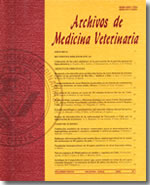Serologic response and time to eradication in herds with brucellosis vaccinated with strain 19 or strain RB-51; 10th Region, Chile
Main Article Content
Abstract
The serologic response to brucellosis vaccination and the time to eradication of brucellosis from herds were compared in dairy cattle vaccinated with either vaccine strains 19 or RB-51. Serologic records from 79 herds from the Province of Valdivia, 10th region of Chile, were evaluated. Herds had been enrolled in the Bovine Brucellosis Eradication Program between 1996 and 1999 and were free of brucellosis at the time of this evaluation.
Twenty-six herds, with 540 cows and a pre-vaccination seroprevalence of 14.1%, were vaccinated with brucellosis vaccine strain 19, and 53 herds, with 1104 cows and a pre-vaccination seroprevalence of 7.6% received vaccine strain RB-51. Blood sera were collected at various time intervals and tested for antibodies to Brucella spp. using the card and complement fixation tests. Seroprevalences, time interval from first detection of disease to certification of freedom from infection, and various time intervals within this time frame, number of tests and time intervals between tests were compared. Sixty-six of 369 previously negative cows vaccinated with strain 19 serconverted, but none of 917 previously negative cows vaccinated with strain RB-51 seroconverted. Time to certification ranged from 304 to 1025 days for herds vaccinated with strain 19 (median 481 days), and from 140 to 753 days for herds vaccinated with strain RB-51 (median 401 days; p=0.003). Herd size, heifer replacement policies, type of veterinary assistance and severity of clinical brucellosis signs on farms did not affect any of the time variables. Vaccine strain 19 herds were tested on average 4.4 times, while vaccine strain RB-51 herds were tested only 3.4 times (p<0.001) during the control period; time intervals between tests were not different (strain 19: 126 days; strain RB-51: 121 days; p=0.60). Vaccine strain RB-51 and control policies associated with its use shortened the duration to certification of freedom from disease and required less resources for samply and testy than use of vaccine strain 19.

